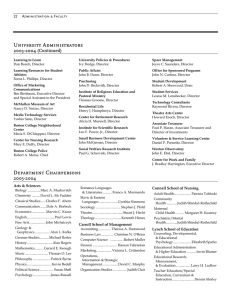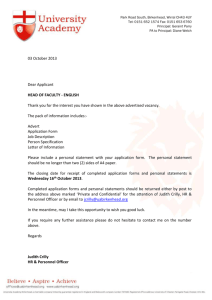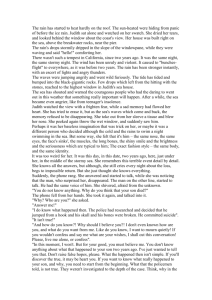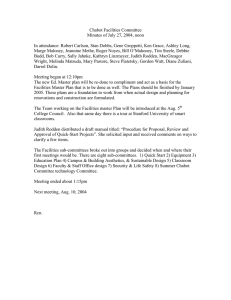FAMILY LAW PRACTICE: A NON-LITIGATION APPROACH
advertisement
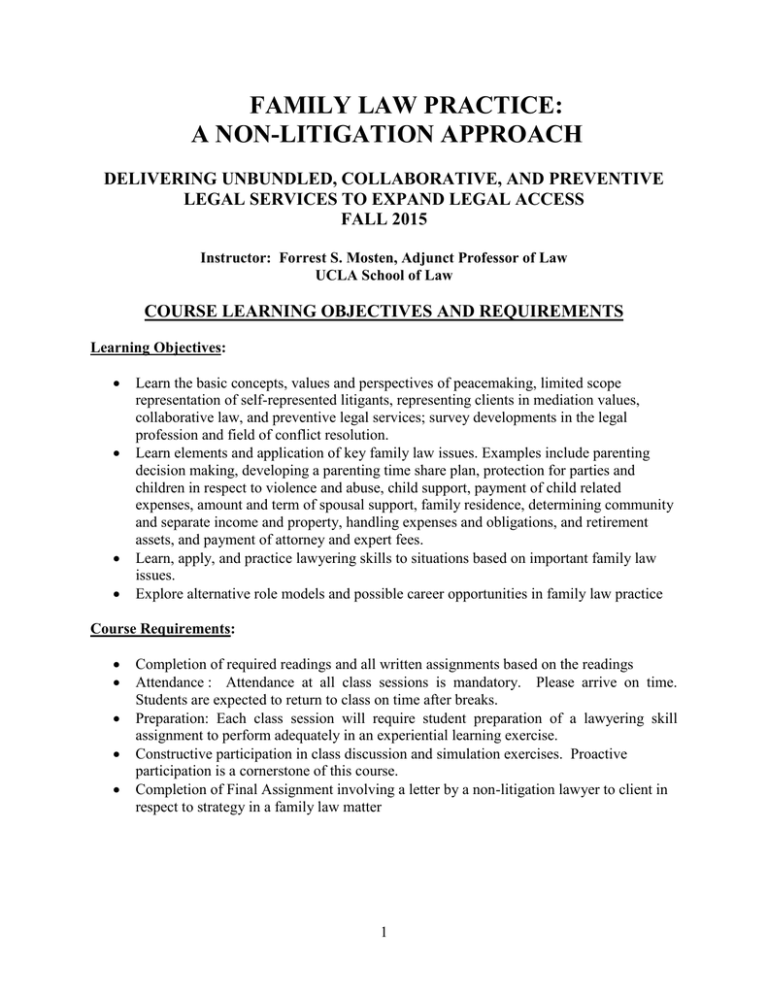
FAMILY LAW PRACTICE: A NON-LITIGATION APPROACH DELIVERING UNBUNDLED, COLLABORATIVE, AND PREVENTIVE LEGAL SERVICES TO EXPAND LEGAL ACCESS FALL 2015 Instructor: Forrest S. Mosten, Adjunct Professor of Law UCLA School of Law COURSE LEARNING OBJECTIVES AND REQUIREMENTS Learning Objectives: Learn the basic concepts, values and perspectives of peacemaking, limited scope representation of self-represented litigants, representing clients in mediation values, collaborative law, and preventive legal services; survey developments in the legal profession and field of conflict resolution. Learn elements and application of key family law issues. Examples include parenting decision making, developing a parenting time share plan, protection for parties and children in respect to violence and abuse, child support, payment of child related expenses, amount and term of spousal support, family residence, determining community and separate income and property, handling expenses and obligations, and retirement assets, and payment of attorney and expert fees. Learn, apply, and practice lawyering skills to situations based on important family law issues. Explore alternative role models and possible career opportunities in family law practice Course Requirements: Completion of required readings and all written assignments based on the readings Attendance : Attendance at all class sessions is mandatory. Please arrive on time. Students are expected to return to class on time after breaks. Preparation: Each class session will require student preparation of a lawyering skill assignment to perform adequately in an experiential learning exercise. Constructive participation in class discussion and simulation exercises. Proactive participation is a cornerstone of this course. Completion of Final Assignment involving a letter by a non-litigation lawyer to client in respect to strategy in a family law matter 1 Instructor’s Office Hours and Communication Instructor will be in his campus office the hour immediately preceding class sessions. If you wish to communicate with the Instructor, the Instructor’s email is mosten@mostenmediation.com and cell phone is 310-721-4291 Assessment Students will receive a letter grade for their participation. Their grade will be calculated as follows: 70% - Student’s preparation for class (completion and knowledge of readings and quality of written assignments) and active and thoughtful participation in class discussion and in role play simulations and lawyering tasks 30% - Final Assignment (take home due by the conclusion of exam period) Based on the concepts and lessons learned in class, each student will write a letter to a client (7-10 pages) based on a family law client fact situation. CLASS FORMAT AND SCHEDULE ALL CLASSES SHALL BE HELD IN ROOM 2483 –Tuesdays 4:30-7:30 PM There are 13 three hour weekly class sessions in this course. Each class will consist of an opening lecture and discussion on a specific lawyering skill in the context of an issue in family law. In the second portion of each class, students will practice the lawyering skill in a fact pattern featuring a family law issue. This practice session will be followed by student reflection and discussion. Students will be expected to complete weekly written assignments in anticipation of featured class material. The final two classes will focus on students conducting mock interviews of clients experiencing a complex family law problem with individual feedback with the instructor. This interview will serve as the basis for the strategic opinion letter that is worth 30% of the class grade. Class #1: Lawyer as Peacemaker: Lawyer-Client Consultation in which lawyer compares traditional lawyering with peacemaking orientation and facilitates discussion with client. Assigned Reading; Mosten, F. S: The Lawyer as Peacemaker (Abridged), ABA Family Law Quarterly, Fall 2009 Do You Have What It Takes To Be a Mediator?” in Mosten, F. S. Mediation Career Guide: A Strategic Approach to Building a Successful Practice. Jossey-Bass, 2001 “The Mediator’s Presence and Personal Qualities of the Mediator” in Bowling, D and Hoffman, D., Bringing Peace Into The Room Mosten, F. S. Beyond Mediation Toward Peacemaking, ACR Magazine, Fall 2013 Binder and Bergman: Lawyer as Counselor 2 Written Assignment Due for Class #1 Write Out Answers To the Following Questions Which Are Due By The Start of Class #1 in a separate document in WORD. Be prepared to provide a client consultation to Judith comparing traditional litigation with a peacemaking approach: 1. What professional and personal values do you bring into your role as a family lawyer for Judith? 2. How do your values impact the way you conduct your initial meeting with Judith and decisions that she needs to make 3. If Judith hired you are hired to file a lawsuit and represent Mom in court, what would you do as her lawyer? 4. How will litigation impact the current conflict for the family and parenting relationship of Judith, Brad, and the children? 5. What would be the financial costs to Judith to have you be her litigator? 6. What is the emotional toll on Judith to get a court result? Class #2: The Family Law Litigation System: Lawyer-Client Consultation with Lawyer Assigned Reading; Lande, J and Mosten, FS, Family Law: Past, Present and Future Letter to Family Law Litigants from Presiding Judge of the Family Law Division, Los Angeles Superior Court Mosten, Memo on the Stages and Timeline of a Litigated Divorce Case Mosten, Memo on an Overview of Parenting and Financial Issues in a Divorce Written Assignment Due for Class #2 Write Out Answers To the Following Questions Which Are Due By The Start of Class #2 in a separate document in WORD. Be prepared to provide a client consultation to Judith describing the overview of the substantive issues in their divorce, the steps of the divorce process, and a range for a time line. 1. 2. 3. 4. 5. 6. What are the parenting decision making issues that will need resolution? What are the parenting time sharing plan issues that will need resolution? What are the issues regarding assets and liabilities that will need resolution? What are the issues regarding child support that will need resolution? What are the issues regarding spousal support that will need resolution? What are the issues regarding payment of attorney fees and expert costs that will need resolution? Class #3 Family Lawyer as an Agent for Reconciliation, Forgiveness, and Facilitator of Apology: Four Way Conferences 3 Assigned Reading; Burnett, N, “Peace, Authenticity, Role of the Practitioner of Peace, Listening, Caring and Humility from Calm in the Face of the Storm Cloke, K, Designing Heart-Based Systems to Encourage Forgiveness and Reconciliation in Divorcing Families Mosten, Memo on Protocol of Making/Accepting an Apology and Providing Forgiveness Written Assignment Due for Class #3 Draft a letter (2-3 pages) to Judith/Brad (you will be assigned a client) describing how the four way settlement conference will work, the opportunity for reducing the ongoing conflict through apology, the possible subjects of apology, how to give an apology and ask for forgiveness, how to accept an apology from the other party and provide forgiveness. Class #4: Lawyer as Manager of Dispute Resolution: Client Consultation Assigned Reading; Macfarlane, J. The New Lawyer: How Settlement Is Transforming the Practice of Law. Mosten and Scully, Lawyer as Manager of Dispute Resolution, Complete Guide to Mediation, 2nd Edition Lewis, T, Helping Families By Maintaining A Strong Well-Funded Family Court That Encourages Consensual Peacemaking: A JUDICIAL PERSPECTIVE ADR Pledge of the Beverly Hills Bar Association Written Assignment Due for Class #4 Write Out Answers To the Following Questions Which Are Due By The Start of Class #4 in a separate document in WORD. Be prepared to provide a client consultation to Judith comparing litigation with mediation with parties only, mediation with lawyers present, and with collaborative law based on the following criteria: emotional impact on the parties, their parenting relationship and on their children; speed of result; privacy, control over the process, and cost, 1. What criteria would you use to compare and contrast litigation with other options and the other options with each other? 2. How would you compare and contrast litigation with mediation between the parties without lawyers present in the mediation? 3. How would you compare and contrast litigation with mediation between the parties with lawyers being present in the mediation? 4. How would you compare and contrast litigation with negotiation in an out of court settlement conference between the parties and their lawyers? 5. How would you compare and contrast litigation with negotiation in an out of court settlement conference between the Judith, you, and Brad who is unrepresented? 6. How would you compare and contrast litigation with Collaborative Law? 4 Class #5: Lawyers and Therapists Working as an Interdisciplinary Team for Family Adjustment and Child Custody: Client Consultation Discussing Use of a Therapist Assigned Reading; Gamache, S. Family Peacemaking with an Interdisciplinary Team: A Therapist’s Perspective Mosten, F, Co-Mediation with a Lawyer-Therapist Team Lewis, T, Helping Families By Maintaining A Strong Well-Funded Family Court That Encourages Consensual Peacemaking: A JUDICIAL PERSPECTIVE Statutes and Case Law on Court Ordered Counseling Statutes and Case Law on Court Ordered Custody Mediation Riskin, L. L., and Welsh, N. “Is That All There Is? The Problem’ in Court-Oriented Mediation Written Assignment Due for Class #5 Write Out Answers To the Following Questions Which Are Due By The Start of Class #5 in a separate document in WORD. Be prepared to conduct a discussion with Judith about use of a therapist to assist with parenting communication and helping her adjust to the divorce 1, How can a therapist help Judith deal better with parenting issues? 2. What words will you use in raising the need for Judith to consult a therapist and what benefit Judith will obtain from working with a therapist? 3. How will a therapist work with Judith? What is the time commitment, cost, and specific obligations that Judith must take on in working with a therapist? 4. How will the therapist involve you as Judith’s lawyer in the therapy process? What authorizations and releases are necessary? 5. How does court ordered counseling get started and operate? 6. What are the criteria that will be used in selecting a therapist? 7. How ill Brad and/or the children be involved in Judith’s therapy? 8. How does court ordered mediation work? What are some of the issues involving confidentiality and effectiveness of court ordered mediation? 9. What is co-mediation and how does it compare with mediation conducted by a sole mediator? What are the potential backgrounds of co-mediators that can be considered? Class #6: Fostering Parenting and Custody Plans with High Conflict Families: Negotiating the Protocol of a Child Custody Evaluation Assigned Reading; Lund, M, The Place for Custody Evaluations ina Family Peacemaking 5 Mosten, Confidential Mini Child Custody Evaluation Stahl and Simon, Child Custody Evaluation Mosten, Memo on selected Statutes and Case Law on child custody evaluations Written Assignment Due for Class #6 Draft a letter (2-3 pages) to the other lawyer (client will be assigned) proposing confidential child custody evaluation covering the following issues: 1. 2. 3. 4. 5. 6. 7. What are the qualifications for the proposed evaluator? How will the evaluator be selected? How will the evaluator will be paid How will communication work between evaluator and parties, children, and lawyers? What other people the evaluator will interview? How evaluator will provide feedback? Role of the evaluator after feedback is provided to parties and lawyers. Class #7: Lawyer as Protector of Client Safety/Protection Against Domestic Violence: Client Interview with Therapist Present Assigned Reading; Laviolette, A, It Could Happen to Anyone Statutes and Case Law on Domestic Violence and Restraining Orders Mosten and Kaiser-Board, The Violent Family: Its Impact on the Lawyer-Client Relationship Binder and Bergman: Lawyer as Counselor Written Assignment Due for Class #7 Write Out Answers To the Following Questions Which Are Due By The Start of Class #7 in a separate document in WORD. Be prepared to conduct a discussion with Judith with a therapist present about strategies to protect her from physical abuse and to protect the children from emotional harm 1. What facts point out to the presence of actual or potential physical abuse? 2. What facts point out to the presence of actual or potential emotional abuse? 3. Should Judith consider leaving the family residence or initiating court proceedings to remove Brad from the residence? 4. What emergency housing and social services are available if Judith leaves the residence? 5. What counseling should the family consider? 6. How can Judith maximize safety and protection during negotiations or court proceedings? 6 Class #8: Self-Represented Litigants In Family Courts: Informed Consent and Ethical Challenges Assigned Reading; Macfarlane, J., Identifying and Meeting the Needs of Self--Represented Litigants (May 2013, Canada Greacen, John, Self-Represented Litigants and Court and Legal Responses to Their Needs: What We Know (Skim) Talia, Sue Limited Scope Representation in Reinventing the Practice of Law (ABA 2014) ABA Legal Needs Assessment (1994) Limited Scope Lawyer Client Agreement California State Court Report on Family Law Courtroom Judicial Council Form FL-950—Notice of Limited Scope Appearance Written Assignment Due for Class #8 Write Out Answers To the Following Questions Which Are Due By The Start of Class #8 in a separate document in WORD. Be prepared to have a consultation with Judith to discuss the differences between full and limited scope representation, assess her and her issues as being suitable for limited scope, provide informed consent, and allocate responsibilities for work between lawyer and Judith 1. How do you assess whether Judith is a Self-Represented Litigant (SLR) when you first come into contact with her? 2. Do you offer limited legal services? If so, what are the reasons? If not, what are the reasons? 3. Do you offer both full services and limited services? If so, how does Judith know what you offer before she calls you? 4. How do Judith’s demographics fit in with the prototype SLR? 5. What would be Judith’s motivations for self-representing? 6. Does Judith have the ability and skills to successfully be a SLR? 7. What resources are there for Judith to get legal information and help to be a SLR? 8. If you were just to meet with Judith once, what value could you offer Judith in deciding whether to be a SLR? 9. If Judith chooses to be SLR, what emotional and social challenges will she face? 10. What initial confidence do you believe Judith would have that she could successfully self-represent? 11. What initial fears do you believe Judith would have that she could successfully self-represent and not get overwhelmed? 12. Assuming that Judith has the following typical concerns of self-represented litigants, how would you address them? a) She believes that despite paying you, you could do very little more than she can to resolve her matter; b) She is concerned that you will not stand up for her with Brad and his family 7 c) She believes that you may push the case to court and not try to settle d) She doubts that you will really listen to her and hear her needs and concerns e) She does not believe that you will be clear and relevant in your explanations of options and her rights f) She wonders whether you have the competence to handle her matter 13. Are you the appropriate lawyer to offer Judith limited scope services? 14. Is unbundling appropriate for Judith? 15. What benefits and risks regarding unbundling would you wish to address with Judith in your next client conference? 16. What additional facts do you believe Judith needs to resolve her problem? 17. How would you and Judith divide the work to gather and present those facts? 18. How would you charge for your services? Why would your services be cost effective for Judith Class #9: Limited Scope Representation of Self-Represented Litigants: Informed Consent, Ethical Challenges, Ghost Writing, Negotiation, and Working with Adverse Parties Assigned Reading; Talia, Sue Limited Scope Representation in Reinventing the Practice of Law (ABA 2014) Ethical Opinions and Court Rules on Ghostwriting and Contact with Represented Parties (Florida and California) Mosten, Unbundling to Enhance Peacemaking for Divorcing Families Written Assignment for Class #9 Write Out Answers To the Following Questions Which Are Due By The Start of Class #9 in a separate document in WORD. Be prepared to have a meeting with Judith to help her fill out court forms seeking orders in child support and coaching Judith for her negotiations with Brad alone and then with Brad’s attorney 1. Assuming that Judith wants your help in drafting a letter to Brad, how would you and Judith divide the work? 2. What steps would you take to draft the letter? 3. Assume that after receiving the letter, Judith indicates that she wants to go to mediation. 4. What issues would you discuss with Judith about whether or not to accept Brad’s invitation to go to mediation? 5. What limited role would you play in setting up the mediation, preparing for the mediation, attending the mediation, and reviewing any agreements? 8 Assume that the mediation does not settle the case. Brad has hired an attorney and filed a Petition to void the will and have the assets divided pursuant to her parents’ alleged oral promise. The hearing on the Petition is in 3 weeks. 6. What limited role you could play in obtaining facts from Brad? 7. What limited role you could play in preparing documents and witnesses for the hearing if Judith represents herself in court? 8. What limited role you could play attending the upcoming court hearing and what tasks you would do and what tasks Judith would do. Class #10: Collaborative Law: Participation Agreement and Interdisciplinary Professional Team Assigned Reading; Mosten, F.S. “Collaborative Law: What It Is and How It Works” and “Structuring the Interdisciplinary Practice Model” in Collaborative Divorce Handbook, Jossey- Bass, 2009 Los Angeles Collaborative Law Association Collaborative Law: Principles and Guidelines Cameron, N, Deepening the Dialogue Uniform Collaborative Law Act (Selected Sections) Lande, J., and Mosten, F. S. “Collaborative Lawyers’ Duties to Screen the Appropriateness of Collaborative Law and Obtain Clients’ Informed Consent to Use Collaborative Law.” Memo on Ethical Issues in Collaborative Practice Written Assignment for Class #10 Write Out Answers To the Following Questions Which Are Due By The Start of Class #10 in a separate document in WORD. Be prepared to have a meeting with Judith, Brad, the other collaborative lawyer and coach to negotiate the terms of a Collaborative Participation Agreement and make opening statements of the parties How does CL differ from traditional negotiation in the “Shadow of the Law?” How does early intervention differ from the litigation model? How does CL differ from mediation? How can CL work in conjunction with mediation? How does CL differ from Cooperative Law? What are the key values of CL? How would you show respect and dignity for Brad and his family and still help Judith? Given their current conflict, how could Judith show respect and communicate directly with Brad? What would healing look like for this family? How does interest based negotiation differ from the way Judith and Brad are handling their dispute at the present time? What role and responsibilities would Judith have in the CL process? 9 How can you competently represent Judith if you are not permitted to threaten or file any court action to gain her leverage? Why could CL be a viable option for Judith? What are the risks for Judith in selecting CL? What are different models of CL available to Judith? What are the key elements of the Attorney-Client Engagement Agreement and the Four Way Participation Agreement? Why do you need both documents signed? How does CL offer an interdisciplinary approach? Describe the steps of the CL process How would you engage and convene Brad to start CL? What role would you play in the CL process (Representative, Advocate, Ally, Consultant, Coach Educator, Manager, Counselor at Law)? How would you handle resistance by Brad or his attorney to CL or if they want a different CL model? What would be your agenda for the first joint session? What other professionals might be necessary to make the process work? How would you work collaboratively with other CL professionals? How would you estimate fees for Judith in CL? How would fees compare with mediation or traditional representation? Class #11: Preventive Law: Premarital Agreements Assigned Reading; Barton, T., Preventive Law and Problem Solving: Lawyering for the Future, Vandeplas 2009 Brown, L Preventive Legal Personal Legal Wellness Check-up Rosenbloom, S. M., and Nesburn, J. “Isn’t It Unromantic: Collaboratively Negotiating Pre and Post Nuptial Agreements Statutes and Cases on Premarital Agreements Premarital Agreement Client Questionnaire (Skim) Written Assignment for Class #11 Write Out Answers To the Following Questions Which Are Due By The Start of Class #11 in a separate document in WORD. Be prepared to discuss the parameters of a premarital agreement and key issues regarding the family residence, community investments, and limitation of spousal support as well as conduct a preventive legal check-up 1. How does your professional relationship with Judith permit a preventive approach? 2. Assuming you work out a settlement for Judith, how do you determine when is the next time you will be in contact with Judith? Who will initiate this contact 3. How do you describe your preventive role to Judith? 4. How are fees and preventive planning initiated by you handled? 10 5. How do you differentiate your role as an advisor and that of a provider of needed preventive services? 6. How do you probe for legal soft spots and latent need? 7. How is a focus on legal rights and duties different from a preventive approach? 8. How does an unspoken and unresolved lawyering approach differ from a preventive approach? 9. How is a preventive approach different from resolving a past event for Judith? 10. How is a preventive approach different from resolving a current crisis for Judith? 11. What is symptomatic preventive planning for Judith? 12. What is asymptomatic preventive planning for Judith? 13. How can a systematic and broad approach be employed for Judith? 14. How can the design of your office impact a preventive approach? 15. How can you be a client educator for a proactive approach for Judith? 16. What educational resources and curriculum can you provide for Judith? 17. What type of adult learning methods can you use to empower Judith and teach her to be an effective client? 18. What elements of a Dispute Resolution Clause would you recommend for Judith to handle future disputes? 19. What opportunities exist for preventive mediation in Judith’s situation? 20. How will any agreement reached between Brad and Judith be monitored for compliance and success? Can you activate a calendar to alert and track preventive steps? 21. How would you employ life cycle planning to prevent future legal angina in this family? 22. How would you use a Preventive Legal Check-up to help Judith assess her Legal Wellness? 23. When do you close Judith’s file, if ever? Class #12: Final Client Interviews Read Fact Patterns & Prepare Questions for Final Client Interviews to be videotaped Class #13: Video Feedback Client Consultations Video Feedback of Client Consultation with Instructor Opinion Letter due December, 2015. 11
